Menus
- Use of force
- Driving report Kawasaki GP Z 900 R
- Kawasaki GP Z 900 R: the chassis
- Kawasaki GP Z 900 R: driving impression
- Kawasaki GP Z 900 R: first conclusion
- Kawasaki GP Z 900 R: technical data
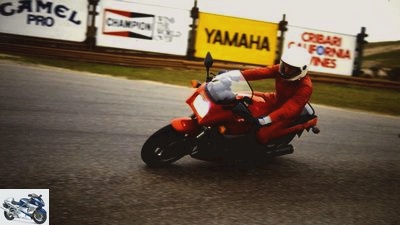
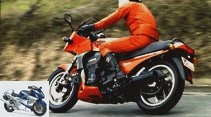
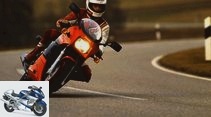
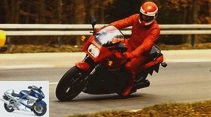
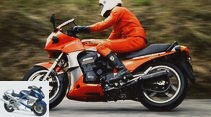
26th photos
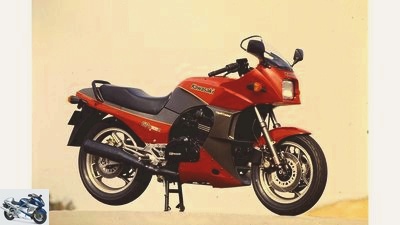
1/26
The formula for the Kawasaki superbike of the 1980s, the GP Z 900 R, was light, strong and fast.
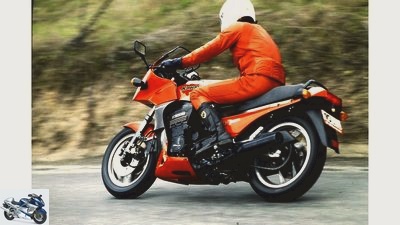
2/26
According to today’s standards, such a sitting posture is called at best "touring sporty".

gad
3/26
The MOTORRAD test drivers chased the endurance test Kawasaki GPZ 900 R over 100,000 kilometers – "from the North Cape to Gibraltar".
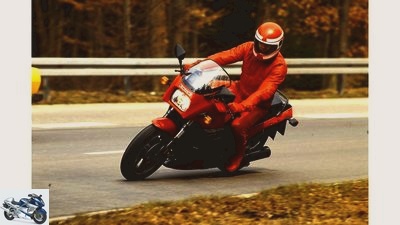
Schwab
4/26
And here a little guessing picture: The rear of which car has cheated into the photo?
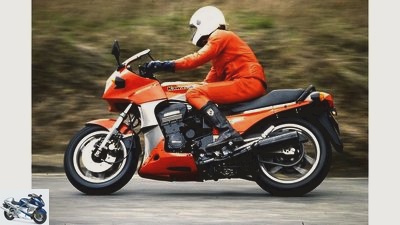
5/26
Notes from the MOTORRAD endurance test: The Kawasaki GPZ 900 R "is characterized by safe driving behavior even after high mileage".
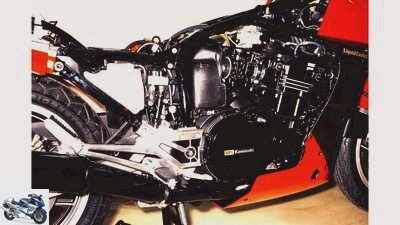
6/26
The first four-valve cylinder head on a Kawasaki production motorcycle had short, straight suction paths. The Kawasaki GPZ 900 R had the camshaft drive on the left side of the engine.
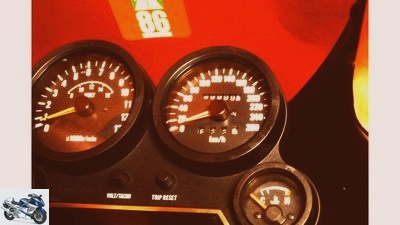
7/26
The instruments of the Kawasaki GPZ 900 R were clearly laid out, but were sometimes considered to be imprecise.
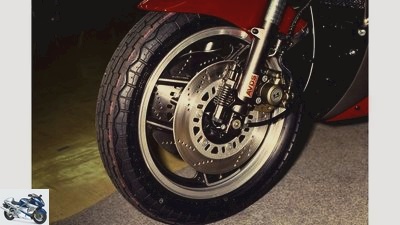
8/26
The ADVS ("Automatic Variable Damping System") is designed to progressively dampen the suspension of the 16-inch front wheel.

9/26
Then as now, MOTORRAD completely dismantles its endurance test motorcycles at the end of the distance.
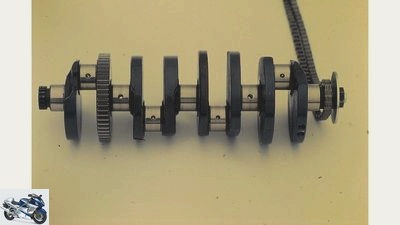
10/26
The crankshaft of the Kawasaki GPZ 900 R, viewed from the front. The chain (on the right in the picture) drives the two overhead camshafts on the left side of the engine.
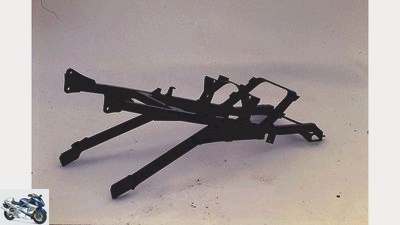
11/26
The screwed-on rear frame would have made repairs much easier, perhaps even made it possible in the first place. Fortunately, this was never necessary in the MOTORRAD endurance test of the Kawasaki GPZ 900 R..
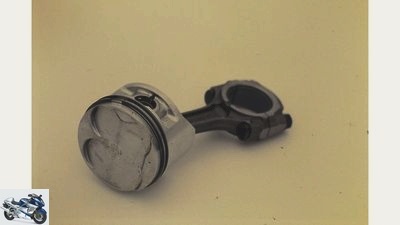
12/26
After 100,000 kilometers, a worn fourth piston appeared on the long-term Kawasaki GPZ 900 R.. "The only engine wear besides the inner valve springs", noted the protocol.
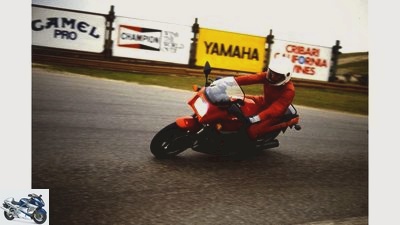
13/26
The Kawasaki GPZ 900 R also cut an excellent figure in the roundabout on the racetrack.
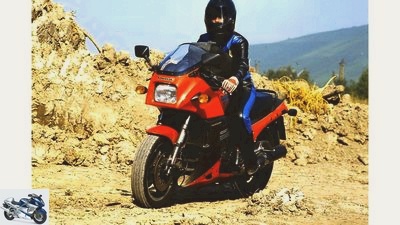
14/26
Gravel roads may not be the preferred habitat of the Kawasaki GPZ 900 R, but they made sense.
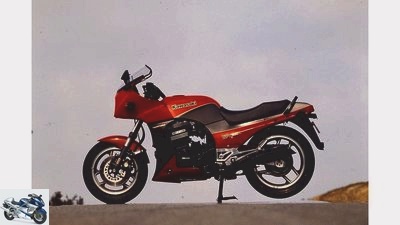
15/26
With 115 hp and a top speed of over 240 km / h, the Kawasaki GPZ 900 R should build on the success of the 900 Z1 from 1972.
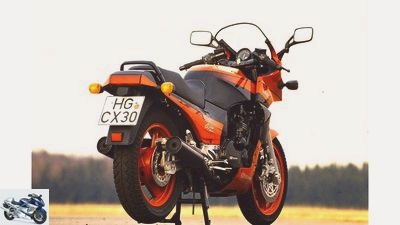
gad
16/26
The Kawasaki GPZ 900 R quickly developed into a successful model: around 2500 units were sold in Germany as early as 1984.
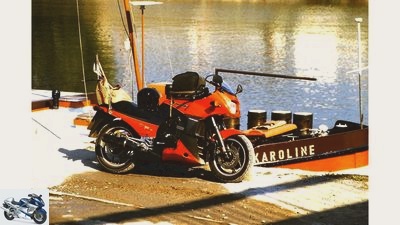
archive
17/26
The Kawasaki GPZ 900 R was also a popular companion in the MOTORRAD endurance test for tours with medium and large luggage.
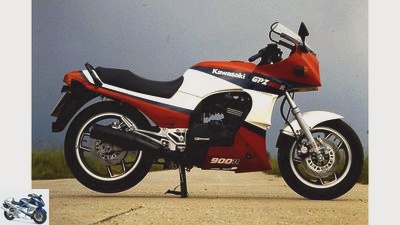
18/26
The Kawasaki GPZ 900 R appears in the red-white-red paintwork …
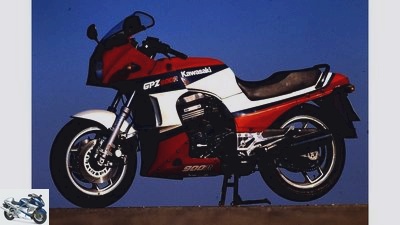
19/26
… a little less martial.
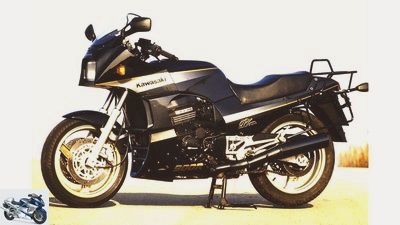
Schwab
20/26
It looks completely different in black with metallic applications.
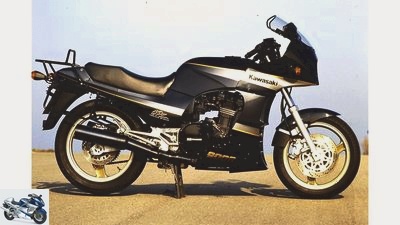
Schwab
21/26
Despite the case and luggage rack structure, the Kawasaki GPZ 900 R retains the aura of a very fast sports motorcycle.
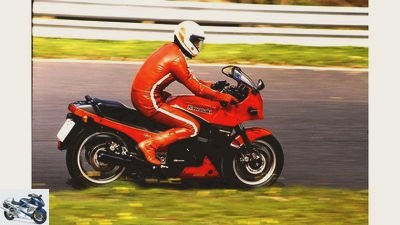
Armies
22/26
Sporty driving is always possible on the Kawasaki GPZ 900 R..
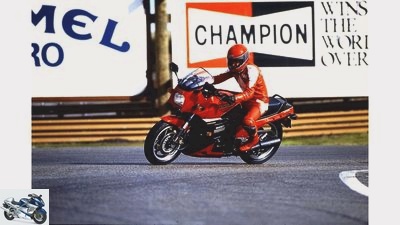
23/26
The "champion"-Advertising in the background of the picture is certainly a coincidence – but a pretty one.
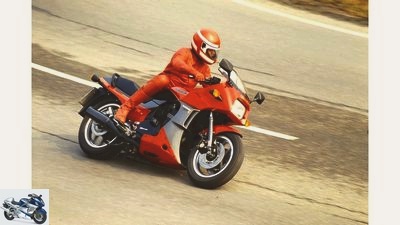
Schwab
24/26
The fact that the throttle variant of the Kawasaki GPZ 900 R available in Germany was limited to 100 hp (open power: 115 hp) did not diminish its success.
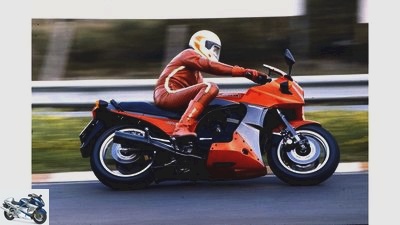
Armies
25/26
According to MOTORRAD measurements, the Kawasaki GPZ 900 R reached a top speed of 239 km / h ("lying solo").
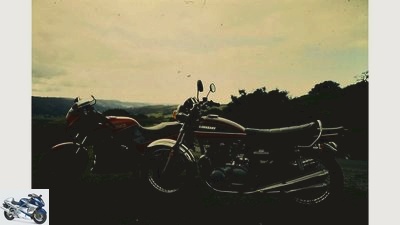
26/26
Then as now, a popular reference: the Kawasaki 900 Z1.
First driving report of the Kawasaki GPZ 900 R (MOTORRAD 1/1984)
Use of force
Kawasaki discovered a new trend. Less displacement, but even more technology, that should make the GP Z 900 R a hit: the fastest motorcycle in the world.
Driving report Kawasaki GP Z 900 R
[NOTE: The above PDF contains scans from the driving report for Kawasaki GP Z 900 R from MOTORRAD 1/1984, from the 25,000 km test from MOTORRAD 10/1985 and from the 100,000 km test from MOTORRAD 11/1986.]
Buy complete article
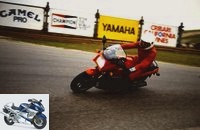
First driving report of the Kawasaki GPZ 900 R (MOTORRAD 1/1984)
Use of force
Kawasaki GP Z 900 R: the engine
archive
Water-cooled inline four-cylinder, 901 cm³, dohc valve drive, timing chain on the left side of the engine.
It took a good four years from the first considerations to his "new generation of high performance" (So the announcement of the GP Z 900 was a finished product. "During this time, we checked every conceivable concept", assures product planner Misao Yurikusa, "from four-cylinder boxer to V-six, but in the end the in-line four-cylinder proved to be the best solution. It can be made sufficiently compact, is lighter than a V-engine because it has fewer parts, and is the cheapest to produce."
In order to achieve the set goal, the technicians in Akashi could not do without technical achievements such as water cooling and four valves per cylinder. In modern high-performance engines, thermal difficulties are primarily caused by the narrow valve angles, which must ensure a compact and therefore knock-proof combustion chamber shape. In addition, this type of temperature control made it possible to position the toothed chain for driving the two overhead camshafts on the left-hand side of the engine without the thermal and to disturb the optical balance of the four-cylinder.
This gave the engineers the opportunity to make the engine even narrower, and they were able to implement straight intake paths because the distances between all cylinders are identical.
Another new feature at Kawasaki is the control of the valves via forked rocker arms, which should make the motorcycle more maintenance-friendly. On the other hand, the aim of switching to plain bearings on the crankshaft was more smoother running. But that’s not all of the tranquilizers: an additional balancer shaft rotates at the bottom of the housing – a novelty for an in-line four-cylinder in a motorcycle. It is driven by the third gear between the third and fourth cylinders, which also transmits the power to the clutch. Another auxiliary shaft drives the water pump, and a third shaft above the gearbox sets the alternator in motion.
The effort related to the actually simple engine essentially served to improve driving behavior and the desired super performance. Because of the extremely narrow design of the engine, the whole machine could be kept compact, and the low vibration was beneficial to the frame design. Because it was only thanks to the balance shaft that the Kawasaki technicians dared to hang the engine rigidly in the frame and assign it a load-bearing function.
Kawasaki GP Z 900 R: the chassis
archive
The Automatic Variable Damping System (AVDS) of the Kawasaki GP Z 900 R was supposed to create progressive damping on the front wheel.
This not only made the GP Z 900 chassis lighter, the engine could also be lowered, and there was more space to nestle the exhaust system close to the housing. The frame itself, called the Diamond Frame, actually consists of four parts: the central section from the steering head to the rear engine mounting, two aluminum side plates that support the footrests and swing arm, and the aluminum rear section that actually only has to hold the seat. All parts are screwed together, which makes repairs easy and cheap. In addition, the Kawasaki engineers claim that the most important advantage of this principle is that they have saved around five kilograms in weight.
But that is not the end of the list of new features that the 900 series has to offer. "With our AVDS", so manager Yurikusa, "For the first time in motorcycle history, progressive damping is also available on the front wheel." The telescopic fork regulates the damper hardness automatically, not only depending on the path, but also on the compression speed. Additional holes in the "Automatic Variable Damping System", which allow the fork oil to flow through when the suspension is to be soft. With hard hits, however, and also from a spring travel of 50 millimeters, small springs close these openings immediately, the fork becomes harder.
After all, with all these innovations, Kawasaki was able to bring itself to the point of clamping a 16-inch front wheel between the fork legs like the competition. Misao Yorikusa: "In addition to the slight improvement in handling, it was important for us to make the motorcycle lower and therefore faster, which is only possible with a smaller front wheel.
Kawasaki GP Z 900 R: driving impression
Armies
The Kawasaki GP Z 900 R can withstand rotational horrors of up to 12,000 rpm, but thanks to the crisp six-speed gearbox it doesn’t need it.
In bare technical data, the result of all this work reads like a form of force majeure: 115 PS, which occur at 9500 rpm, should really have little trouble with the dry weight of 220 kilograms. For German customers, however, this is no longer that fantastic, because a waiver of 15 hp is offset by a difficulty of 29 kilograms until the vehicle has passed the TÜV, filled with all operating materials.
At the world presentation on the Californian Pacific coast, on the Laguna Seca race track, MOTORRAD still had the pleasure of driving the open version. That the engine is really one "new generation" embodied is undeniable. Compared to the previously available Kawasaki four-cylinder engines, in particular, it appears much more refined, less strenuous and also more spontaneous in its power delivery.
The higher it is turned, the more comfortable the propellant of the GP Z 900 R is. Neither the maximum power at 9500 rpm nor the beginning of the red area at 10,500 rpm mark the end of the willingness to turn. The short stroke (bore 72.5 mm, stroke 55 mm) can withstand up to 12,000 rpm without damage. Such orgies are actually superfluous due to the short and crisp six-speed gearbox, they only happen in the heat of the moment. The needle of the tachometer should not fall below the 7000 mark, because the four-valve machine lacks 200 cc and the corresponding thrust, as actually only available in 1.1-liter superbikes.
Slight vibrations could only be noted on one of the three specimens driven by MOTORRAD. We have to wait and see how the balanced cylinder really runs in mass production. And whether the promised top speed – for the German 100 PS version still 235 km / h – could not be found in Laguna Seca, because the straights were too short and the highways were not open.
It could be determined, however, that the chassis technicians again moved something away from the philosophy of the turbo represented by the firm suspension and the stubborn directional stability at any price. The 900 R looks very easy to maneuver, which is certainly due to the very low seat with a seat height of 780 millimeters and the handlebars that are wide for a sports motorcycle. Fast and slow curve combinations are no longer work with it. Despite the small tire at the front, the chassis remains neutral in all kinds of bends and does not suddenly straighten up when braking in an inclined position.
Kawasaki GP Z 900 R: first conclusion
archive
The MOTORRAD endurance test over 100,000 km in issue 11/1986 drew a detailed summary of the Kawasaki GPZ 900 R.
Criticisms of the latest GP Z tend to be reduced to questions of taste: the front brake grabs quite brutally even with little hand force, the disc in the rear wheel can hardly be properly metered, the instruments are a bit small and clumsy, the arms of the rearview mirror too short.
When asked why Kawasaki voluntarily refrained from increasing the displacement to the level of the Superbike competitors, manager Yorikusa answers with a mysterious smile and the counter-question: "Why do we need 1100 cm³ when we can do it at least as well with 900?"
Kawasaki GP Z 900 R: technical data
archive
Four such 72.5 mm pistons work in the Kawasaki GP Z 900 R..
Engine: Water-cooled four-cylinder four-stroke in-line engine, transversely installed, dohc, Gbel rocker arm, control drive via toothed chain, four valves each bore x stroke 72.5 x 55 mm, displacement 901 cm³, compression 11, rated power 74 kW (100 PS) at 9500 / min, Max. Torque 86 Nm (8.7 mkp) at 8500 rpm, four Keihin carburettors, Ø 34 mm, contactless transistor ignition, three-phase generator, batteries 12 V / 14 Ah, hydraulically operated multi-disc oil bath clutch, claw-shifted six-speed gearbox, electric starter, secondary drive via O-ring chain
Landing gear: Backbone tubular frame with screwed-on rear section, motor-bearing element, air-assisted telescopic fork at the front with hydraulically controlled anti-dive, standpipe diameter 38 mm, automatic damping adjustment, spring travel 140 mm, central, air-assisted gas strut rear, rebound stage 4-way adjustable, spring travel 114 mm, Uni Trak- System, wheelbase 1495 mm, steering head angle 61 degrees, caster 114 mm, double disc brake at the front, Ø 280 mm, fixed caliper, rear disc brake, Ø 270 mm, fixed caliper, front / rear hydraulic actuation, front tires 120/80 V 16, rear 130/70 V 18.
Dimensions and weights: Length 2200 mm, seat height 780 mm, two-part aluminum handlebar, empty weight 249 kg, permissible total weight 430 kg, tank capacity 22 liters
Price: 11,390 marks
Related articles
-
Kawasaki Z 650 in the driving report
Kawasaki 9 photos Kawasaki 1/9 Photo gallery: Kawasaki Z 650 in the driving report. Kawasaki 2/9 The diet worked: Compared to the ER-6n, the Z 650 has…
-
Kawasaki Versys 1000 driving report
Wright Driving report: Kawasaki Versys 1000 (with video) Kawasaki’s all-rounder now with a large four-cylinder No half measures: For the Versys there is…
-
New Kawasaki Ninja ZX-10R (2016) in the driving report
Kawasaki 18 pictures Kawasaki 1/18 Kawasaki Ninja ZX-10R. Kawasaki 2/18 Kawasaki Ninja ZX-10R. Kawasaki 3/18 Kawasaki Ninja ZX-10R. Kawasaki 4/18 Kawasaki …
-
Kawasaki Z 900 in the driving report
Kawasaki 17th photos Kawasaki 1/17 Kawasaki Z 900 Kawasaki 2/17 Dipped in bright green, the new tubular steel lattice frame accommodates the engine as a…
-
Kawasaki Z 1000 SX in the driving report
Photo: Kawasaki 11 photos Kawasaki 1/11 The LED headlights are part of the new front fairing. They should shine brighter and wider at the same time….
-
Driving report new Kawasaki ZX-9R
Driving report new Kawasaki ZX-9R Change on the fly Not even two years on the market, Kawasaki is pushing a completely renovated version of the…
-
Driving report Kawasaki Ninja 400 (2018)
Arturo Rivas 29 photos Arturo Rivas 1/29 Kawasaki has redesigned the entry-level ninja. The twin’s cubic capacity and power increased, which is now…
-
Archive pictures Honda XRV 650 Africa Twin and the driving report from MOTORRAD 09-1988
duke 17th photos duke 1/17 The more bumpy the track becomes, the more clearly the Honda can set itself apart from competitors like the BMW R 80 GS. duke…
-
Driving report Kawasaki Z 900 RS
Kawasaki 35 photos Kawasaki 1/35 Kawasaki Z 900 RS. Kawasaki 2/35 Kawasaki Z 900 RS. Kawasaki 3/35 Kawasaki Z 900 RS. Kawasaki 4/35 Kawasaki Z 900 RS….
-
Photo: Kawasaki 24 photos Kawasaki 1/24 Kawasaki 2/24 Kawasaki 3/24 Kawasaki 4/24 Kawasaki 5/24 Kawasaki 6/24 Kawasaki 7/24 Kawasaki 8/24 Kawasaki 9/24…